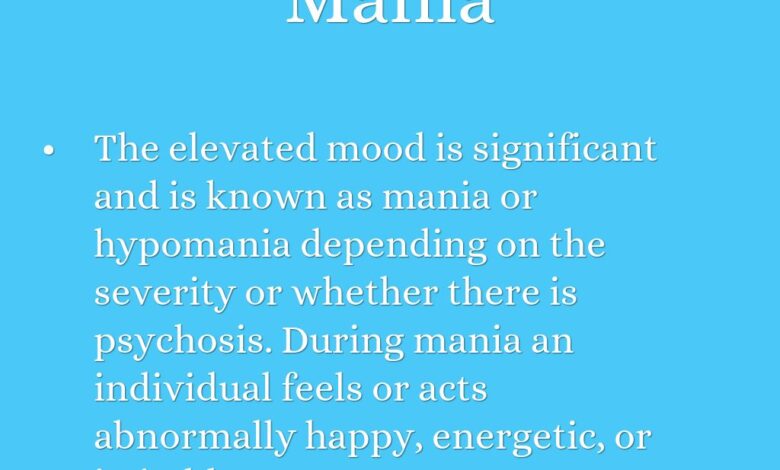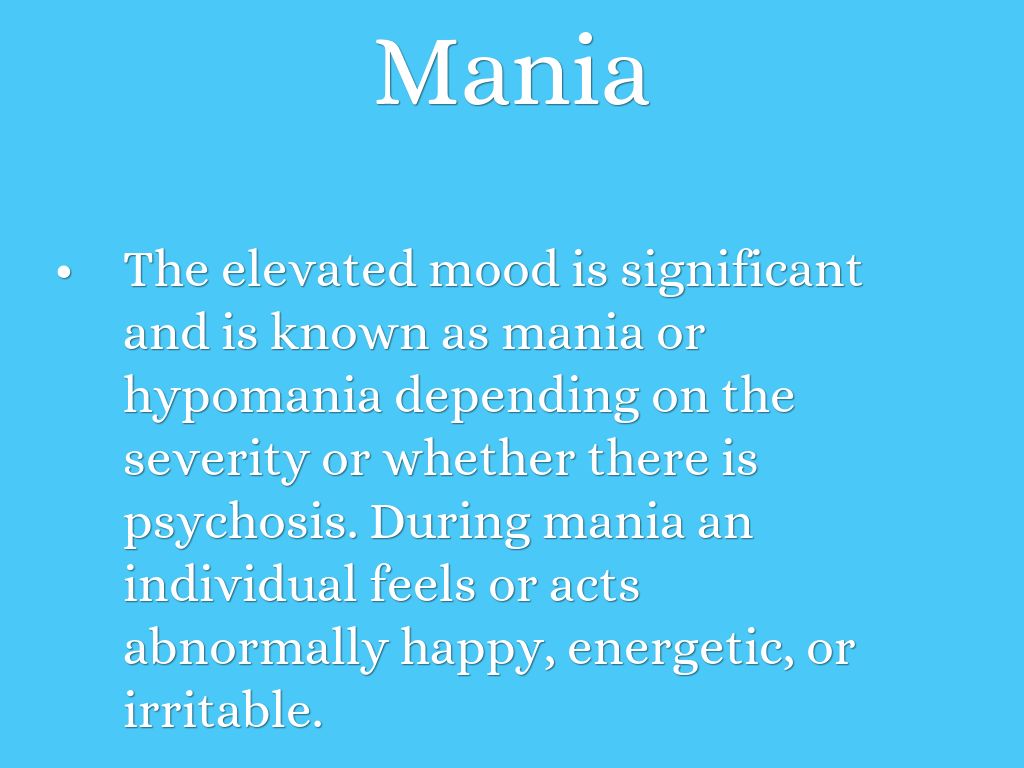
What is mania in bipolar? This sets the stage for an exploration of this complex aspect of bipolar disorder. Mania, a distinct mood state, involves a heightened and often disruptive level of energy, activity, and mood. Understanding its features, causes, impact, and management is crucial for those living with bipolar disorder and those who support them.
This in-depth look at mania in bipolar disorder will cover its defining characteristics, including elevated mood, racing thoughts, and impulsive behaviors. We’ll delve into potential causes, from biological factors to environmental triggers, and examine the significant impact it can have on daily life, relationships, and overall well-being. Finally, we’ll explore diagnostic criteria, treatment approaches, and strategies for living with mania, providing a comprehensive understanding of this crucial aspect of bipolar disorder.
Defining Mania in Bipolar Disorder
Mania, a crucial component of bipolar disorder, is characterized by an abnormally elevated or expansive mood, accompanied by a significant increase in energy and activity. Understanding this state is vital for accurate diagnosis and effective treatment. It’s important to remember that manic episodes vary in severity and presentation across individuals.This elevated mood state often manifests as an intense and persistent sense of well-being, optimism, and boundless energy.
The individual may feel invincible and capable of extraordinary feats, which can lead to impulsive decisions and risky behaviors. This heightened state often disrupts daily life and interpersonal relationships.
Key Features and Symptoms of Mania
Mania is defined by a distinct period of abnormally and persistently elevated, expansive, or irritable mood. It significantly disrupts normal functioning and often requires hospitalization for safety. This period is accompanied by a noticeable change in activity levels and a marked alteration in thinking patterns.
- Elevated or Expansive Mood: This includes feelings of euphoria, grandiosity, and an inflated sense of self-importance. Individuals might believe they possess exceptional abilities or have extraordinary insights.
- Increased Activity and Energy: Individuals experiencing mania often exhibit a heightened level of energy, requiring less sleep than usual, and undertaking multiple activities simultaneously. This can manifest as racing thoughts, rapid speech, and impulsive behaviors.
- Racing Thoughts and Flight of Ideas: Rapid shifts in thoughts and ideas, often leading to difficulties in maintaining focus and concentration. This can also involve a sense of pressure to keep talking or thinking.
- Distractibility: A reduced ability to filter out external stimuli, making it difficult to concentrate on tasks or conversations.
- Increased Impulsivity: Engaging in impulsive behaviors without considering potential consequences, such as reckless spending, impulsive sexual encounters, or excessive risk-taking.
- Increased Talkativeness (Pressured Speech): Rapid and continuous speech, sometimes with difficulties in pausing or allowing others to speak.
Hypomania vs. Mania
While both hypomania and mania represent elevated mood states, they differ in severity and impact on daily functioning. Hypomania is less severe than mania and doesn’t typically impair social or occupational functioning to the same degree.
- Hypomania: A less severe form of mania, typically lasting at least four consecutive days. It is characterized by an elevated or expansive mood but does not cause significant impairment in social or occupational functioning. Individuals might feel more energetic, creative, or productive, but the symptoms don’t disrupt their daily lives to the extent of a manic episode.
- Mania: A more severe form of elevated mood that significantly disrupts social and occupational functioning. It is typically more intense and lasts longer than hypomania. It may require hospitalization for safety.
Observable Behaviors Indicative of Mania
Recognizing the behavioral manifestations of mania can aid in early identification and intervention. It’s important to consider the context and individual baseline behavior to determine if the observed behaviors are indicative of mania.
- Increased Spending: Significant and often excessive spending on items or experiences, regardless of financial capacity.
- Risky Behaviors: Engaging in dangerous or reckless behaviors, such as speeding, unsafe sexual practices, or substance abuse, without considering the potential consequences.
- Decreased Need for Sleep: Experiencing a significant reduction in the need for sleep without experiencing fatigue or impairment.
- Grandiose Ideas: Holding inflated opinions of oneself or one’s abilities, believing one possesses special talents or insights.
- Increased Sexual Drive: Marked increase in sexual activity and drive, often without regard for boundaries or safety.
Comparison of Mania with Other Mood States
| Mood State | Key Characteristics | Impact on Functioning |
|---|---|---|
| Mania | Elevated or expansive mood, increased energy, racing thoughts, impulsivity, decreased need for sleep | Significant impairment in social and occupational functioning; often requires hospitalization |
| Hypomania | Elevated mood, increased energy, racing thoughts, impulsivity, decreased need for sleep | Less severe impairment in social and occupational functioning; typically does not require hospitalization |
| Depression | Persistent low mood, loss of interest, fatigue, feelings of worthlessness | Significant impairment in social and occupational functioning |
Understanding the Causes of Mania
Mania in bipolar disorder isn’t a simple, single-cause phenomenon. Instead, it’s likely a complex interplay of various factors, making pinpointing a single culprit challenging. Research suggests a combination of genetic predisposition, environmental triggers, and neurochemical imbalances contribute to the development and expression of manic episodes. Understanding these elements is crucial for developing effective preventative and treatment strategies.
Biological Factors
Biological factors play a significant role in the predisposition to and expression of manic episodes. Brain structure and function, particularly in areas associated with mood regulation and reward pathways, are likely involved. Neuroimaging studies have shown differences in brain volume and activity patterns between individuals with bipolar disorder and healthy controls during manic episodes. These structural and functional differences may reflect underlying biological vulnerabilities.
Mania in bipolar disorder is a tricky thing. It’s characterized by abnormally elevated mood, energy, and activity levels, but sometimes it can get out of control, leading to risky behaviors. It’s crucial to remember that, just like humans, pets have unique needs, and using a human’s prescription medication on a pet is a really bad idea. See what I mean?
people using pet prescription medication terrible idea. This highlights the importance of responsible pet ownership and seeking veterinary advice for any health concerns. Ultimately, understanding mania in bipolar is key to managing it effectively.
Further research is crucial to fully elucidate these complex biological pathways.
Genetic Predisposition
Genetic factors are strongly implicated in the development of bipolar disorder, and therefore, mania. Studies of families and twins have consistently shown a higher concordance rate for bipolar disorder in individuals with a family history of the condition. This suggests a heritable component, although the specific genes involved are not yet fully understood. While specific genes haven’t been identified as sole culprits, research continues to unravel the intricate genetic networks that may contribute to an increased susceptibility to mania.
Environmental Triggers
Environmental factors can act as triggers or exacerbating influences on manic episodes. Stressful life events, such as job loss, relationship problems, or significant changes in routine, can precipitate manic episodes in individuals with a predisposition to bipolar disorder. Substance use, including alcohol and certain drugs, can also contribute to or worsen manic symptoms. Recognizing environmental triggers can be instrumental in developing preventative strategies and managing episodes effectively.
Neurochemical Imbalances
Neurochemical imbalances are believed to be central to the manifestation of manic symptoms. Disruptions in the levels of neurotransmitters like dopamine, serotonin, and norepinephrine are suspected to play a crucial role. Elevated levels of dopamine, for example, are hypothesized to contribute to the heightened energy, racing thoughts, and impulsivity characteristic of manic episodes. Research continues to investigate the specific mechanisms by which these neurochemical imbalances contribute to the experience of mania.
Summary Table: Theories Explaining Causes of Mania
| Theory | Explanation | Supporting Evidence |
|---|---|---|
| Biological Factors | Brain structure and function differences, neurotransmitter imbalances. | Neuroimaging studies, genetic research. |
| Genetic Predisposition | Heritable component increasing vulnerability. | Family and twin studies, genome-wide association studies. |
| Environmental Triggers | Stressful life events, substance use, and other environmental factors. | Case studies, epidemiological studies, stress response research. |
| Neurochemical Imbalances | Dysregulation of neurotransmitters like dopamine, serotonin, and norepinephrine. | Post-mortem studies, animal models, pharmacological studies. |
Recognizing the Impact of Mania

Mania, a hallmark of bipolar disorder, isn’t just about feeling good. It significantly disrupts daily life, relationships, and overall well-being. Understanding the impact of these episodes is crucial for both individuals experiencing mania and their support networks. It’s about recognizing the challenges and seeking appropriate help.Mania can dramatically alter an individual’s perspective and actions, making it difficult to function normally.
This distorted reality often leads to poor choices and behaviors that have long-lasting consequences. Recognizing the impact of these episodes allows for more effective strategies to manage and treat the disorder.
Impact on Daily Functioning, What is mania in bipolar
Mania can derail daily routines, impacting everything from work or school to personal care. The racing thoughts and energy levels often lead to poor judgment and neglect of responsibilities. Individuals might spend excessive time on activities, neglecting other essential tasks, and this can create significant difficulties.
Impact on Relationships
Manic episodes can strain relationships with family, friends, and partners. The inflated sense of self-importance, impulsiveness, and irritability can lead to conflict and misunderstandings. Communication becomes challenging as the individual’s perspective is often distorted, causing hurt feelings and distancing.
Emotional Toll
The emotional toll of mania is substantial, both for the individual experiencing it and those close to them. The rapid shifts in mood, from euphoric highs to intense irritability, can be exhausting and overwhelming. Loved ones may feel helpless, confused, and burdened by the emotional rollercoaster. They might experience feelings of guilt, anger, or frustration at their inability to control the situation.
Potential Risks of Untreated Mania
Untreated mania carries significant risks. Impulsive spending, substance abuse, and reckless behavior are common consequences. The individual might engage in high-risk activities with little regard for the potential repercussions. Financial problems are a common outcome as spending habits are often uncontrolled. This can lead to severe financial distress, jeopardizing their future and potentially that of those around them.
Mania in bipolar disorder is a period of intense elevated mood, energy, and activity. It’s a challenging aspect of the condition, but surprisingly, similar to managing some menopause symptoms, regular physical activity like ways to ease menopause symptoms with walking can be really helpful. Finding healthy coping mechanisms, like exercise, can make a big difference in managing both conditions.
Ultimately, understanding and managing mania requires a personalized approach and support system.
The heightened energy and impulsiveness can also lead to dangerous situations and injuries.
Disruption of Social and Occupational Life
Mania can profoundly disrupt social and occupational life. The individual might neglect social obligations, isolating themselves from friends and family. At work or school, productivity suffers due to impulsive decisions, decreased focus, and absenteeism. This can lead to job loss or academic setbacks.
Examples of Disruptions
- A previously organized individual might suddenly abandon their schedule, neglecting appointments and responsibilities.
- A dedicated student might abandon their studies due to impulsive decisions and an inflated sense of self-worth.
- A responsible employee might neglect their duties and responsibilities, resulting in significant workplace issues.
Areas of Life Affected by Manic Episodes
| Area of Life | Impact of Mania |
|---|---|
| Work/School | Decreased productivity, absenteeism, job loss, academic setbacks |
| Relationships | Conflict, misunderstandings, isolation, strain on relationships |
| Finances | Impulsive spending, debt accumulation, financial distress |
| Health | Neglect of personal care, risky behaviors, potential for injury |
| Social Life | Neglect of social obligations, isolation, strained relationships |
Diagnosing and Managing Mania

Navigating the ups and downs of bipolar disorder can be challenging, especially during manic episodes. Understanding how mania is diagnosed and managed is crucial for individuals and their support networks. Accurate diagnosis leads to effective treatment and improved quality of life.
Diagnostic Criteria for Manic Episodes
The diagnosis of a manic episode relies on a set of specific criteria Artikeld in the Diagnostic and Statistical Manual of Mental Disorders (DSM-5). These criteria provide a standardized framework for clinicians to assess the presence and severity of manic symptoms. Key features include elevated mood, increased activity or energy, and inflated self-esteem, often accompanied by racing thoughts, decreased need for sleep, and impulsivity.
Clinicians consider the duration and severity of these symptoms, as well as their impact on daily functioning.
Importance of Professional Evaluation and Diagnosis
Accurate diagnosis is paramount in managing mania effectively. A qualified mental health professional, such as a psychiatrist or psychologist, plays a critical role in evaluating the individual’s symptoms, medical history, and overall well-being. A thorough assessment ensures that the diagnosis accurately reflects the individual’s experience and helps rule out other potential conditions with similar symptoms. This personalized approach ensures the most appropriate and effective treatment plan.
Role of Medical Professionals
Medical professionals, particularly psychiatrists, are crucial in the diagnosis and management of bipolar disorder. Their expertise in evaluating mood disorders and prescribing medications is essential. They can provide guidance on appropriate medications, monitor treatment effectiveness, and adjust the treatment plan as needed. Collaboration with other healthcare professionals, such as therapists, can further support the individual’s overall well-being.
Psychiatrists are also well-versed in the complex interplay of medications and their potential side effects, ensuring that the chosen treatment approach is tailored to the individual’s needs.
Treatment Approaches for Managing Manic Episodes
Managing manic episodes requires a multifaceted approach. Treatment options commonly include medication, psychotherapy, and lifestyle modifications. The specific treatment plan is individualized based on the severity of the episode, the individual’s response to treatment, and their overall health.
Therapeutic Interventions for Bipolar Disorder
Various therapeutic interventions can complement medication in managing bipolar disorder. Cognitive Behavioral Therapy (CBT) helps individuals identify and challenge negative thought patterns and develop coping mechanisms. Family-focused therapy educates family members about the disorder and empowers them to support the individual effectively. These therapies help individuals understand and manage their mood fluctuations, improving their overall functioning and well-being.
Psychoeducation, a form of therapy, provides essential information about bipolar disorder to both the individual and their support system, promoting better understanding and coping skills.
Treatment Approaches Table
| Treatment Approach | Pros | Cons |
|---|---|---|
| Medication (e.g., mood stabilizers, antipsychotics) | Can effectively reduce manic symptoms, potentially preventing future episodes. Often a crucial part of the initial management of a manic episode. | Potential side effects, such as weight gain, nausea, or drowsiness. Finding the right medication and dosage can take time. Some individuals may not respond well to certain medications. |
| Psychotherapy (e.g., CBT, family therapy) | Provides coping strategies, improves emotional regulation, and enhances communication skills. Helps in understanding and managing the triggers of mood swings. Focuses on building resilience. | May not be as effective as medication in quickly reducing acute manic symptoms. Requires time and commitment from the individual. |
| Lifestyle Modifications | Can support overall well-being, reduce stress, and improve sleep patterns. | May not be sufficient for managing severe manic episodes. Needs to be incorporated alongside other treatments. |
Living with Mania
Navigating manic episodes in bipolar disorder requires a multifaceted approach that goes beyond medication. Effective management involves understanding the triggers, developing coping mechanisms, and maintaining a strong support system. This phase delves into practical strategies for living with mania, focusing on self-care, communication, and adherence to treatment plans.Living with mania can be challenging, but with the right tools and support, it’s possible to manage symptoms effectively and maintain a fulfilling life.
It’s crucial to recognize that mania is not a personal failing, but a complex medical condition requiring proactive management.
Managing Manic Symptoms
Understanding the specific symptoms of mania is the first step in developing personalized management strategies. This involves recognizing patterns and triggers, which can vary from person to person. Identifying personal triggers, such as sleep deprivation, stress, or specific types of social interactions, can significantly enhance the ability to anticipate and mitigate the onset of manic episodes.
Coping with Manic Episodes
Effective coping mechanisms are essential for managing the intensity of manic episodes. These strategies involve learning to recognize early warning signs and employing techniques to calm and regulate emotions. A toolbox of strategies, tailored to individual needs, can provide practical support during manic periods.
- Mindfulness and Relaxation Techniques: Practicing mindfulness exercises, deep breathing, or progressive muscle relaxation can help to ground individuals and reduce feelings of overwhelm during manic episodes. These techniques can be particularly helpful in managing racing thoughts and heightened energy levels. Examples include guided meditation apps or simple breathing exercises.
- Structured Routine: Maintaining a consistent daily routine, even during manic periods, can provide a sense of stability and predictability. This includes establishing regular sleep schedules, mealtimes, and activity patterns. A structured routine can help mitigate impulsive decisions and provide a sense of control.
- Distraction and Engagement: Engaging in activities that provide a healthy outlet for energy and focus can be beneficial. This could include creative pursuits, physical exercise, or engaging in social activities, provided it does not exacerbate manic symptoms. Diversionary activities can help prevent overstimulation and impulsive behaviors.
Self-Care and Stress Management
Maintaining a healthy lifestyle is vital in managing bipolar disorder, including mania. Self-care practices are crucial for reducing stress and promoting overall well-being, contributing to a more stable emotional state. This includes proper sleep, nutrition, and exercise.
Mania in bipolar disorder is essentially a period of intense elevated mood, energy, and activity. It can be quite overwhelming, impacting daily life significantly. Interestingly, the debate around whether coffee needs a cancer warning is a fascinating parallel to this, as both involve discussions about potential health consequences. While the scientific community continues to research the link between caffeine and long-term health, does coffee really need a cancer warning , a crucial question for those who enjoy a morning cup, is important to consider.
Ultimately, understanding the nuances of mania, like examining the potential risks and benefits of coffee, requires a balanced approach.
- Prioritize Sleep: Adequate sleep is crucial for mood regulation. Consistent sleep patterns, even during manic episodes, can help to stabilize mood and prevent further escalation of symptoms.
- Healthy Diet: A balanced diet provides essential nutrients for brain health and overall well-being. A balanced diet can help maintain energy levels and prevent nutritional deficiencies that can impact mood. This includes avoiding excessive caffeine or sugar intake, which can exacerbate manic symptoms.
- Regular Exercise: Physical activity can have a positive impact on mood regulation. Regular exercise can help to reduce stress, improve sleep quality, and boost overall well-being. The right exercise regime can be particularly helpful in regulating mood swings.
Effective Communication Strategies
Open and honest communication with loved ones is essential for navigating manic episodes. This involves educating loved ones about the condition and encouraging them to offer support and understanding.
- Clear Communication: Expressing needs and concerns during manic episodes, in a clear and calm manner, can help to avoid misunderstandings and escalate conflicts. A clear communication style can improve understanding and cooperation.
- Seeking Support: Building a strong support system, including family, friends, or support groups, can provide emotional and practical assistance during manic episodes. This support network can offer valuable perspective and encouragement.
- Setting Boundaries: Establishing clear boundaries with loved ones can help to prevent the escalation of conflicts during manic episodes. Clear boundaries can help ensure that the needs of both parties are respected.
Adhering to Treatment Plans
Adherence to treatment plans is crucial for managing bipolar disorder. This includes taking medication as prescribed, attending therapy sessions, and participating in support groups.
- Medication Adherence: Taking medication as prescribed is vital for managing symptoms and preventing the recurrence of manic episodes. This includes discussing any side effects or concerns with the healthcare provider.
- Regular Therapy: Therapy provides valuable tools and coping mechanisms for managing symptoms and maintaining emotional stability. This includes cognitive behavioral therapy (CBT) or other evidence-based therapies.
- Support Groups: Support groups offer a safe and supportive environment for individuals living with bipolar disorder to connect with others who understand their experiences. These groups provide valuable insights and encouragement.
Actionable Tips for Managing Manic Episodes
| Category | Actionable Tips |
|---|---|
| Early Warning Signs | Recognize early warning signs (e.g., increased energy, racing thoughts, decreased need for sleep) and take preventative measures. |
| Coping Mechanisms | Employ mindfulness techniques, engage in structured activities, and utilize distraction strategies. |
| Self-Care | Prioritize sleep, maintain a balanced diet, and incorporate regular exercise. |
| Communication | Communicate needs and concerns clearly and calmly, and establish clear boundaries. |
| Support System | Seek support from family, friends, or support groups. |
| Treatment Plan Adherence | Take medication as prescribed, attend therapy sessions, and actively participate in support groups. |
Illustrative Examples of Mania
Mania, a crucial component of bipolar disorder, manifests differently in each individual. Understanding these diverse expressions is key to accurate diagnosis and effective treatment. Recognizing the specific symptoms and their impact on daily life is vital for both the person experiencing mania and those who support them.Mania often presents as an overwhelming surge of energy, creativity, and elevated mood.
However, this heightened state can quickly descend into erratic behavior, impulsive decisions, and emotional instability. The specific expressions of mania vary significantly depending on factors like personality, pre-existing conditions, and environmental triggers. Understanding these variations is crucial for both the person experiencing mania and their support network.
Hypothetical Scenarios of Manic Episodes
These hypothetical scenarios depict manic episodes in different individuals, highlighting the diverse ways mania can manifest. Important considerations include the individual’s typical personality and pre-existing conditions.
- A young professional, typically reserved and analytical, experiences a sudden surge in energy and creativity. They start multiple ambitious projects, spend money impulsively on extravagant purchases, and become extremely talkative, rapidly shifting from one topic to another. Their sleep patterns are drastically disrupted, with only a few hours of sleep per night. They become increasingly agitated and irritable when others try to reason with them.
- An artist, known for their introspective nature and intense creative expression, experiences a manic episode marked by a rapid escalation in artistic output. They paint, write, and sculpt tirelessly, often neglecting personal hygiene and basic necessities. Their mood swings between exhilarating bursts of creativity and moments of intense frustration and self-criticism.
- A student, typically organized and focused, exhibits a significant increase in energy and a decreased need for sleep. They begin spending countless hours studying, taking on multiple extracurricular activities, and socializing excessively. Their focus becomes scattered, leading to poor academic performance and interpersonal conflicts. They make impulsive decisions, such as agreeing to travel far away for a meeting with little planning.
Nuances of Mania Across Demographics
Mania can manifest differently across various demographics, influenced by cultural norms and societal expectations.
- Cultural factors can shape how mania is expressed. For example, in some cultures, excessive talking or energetic behavior might be perceived as enthusiasm or charisma rather than a sign of mania. In other cultures, social isolation and withdrawal during manic episodes may be more prevalent.
- Gender differences might influence the presentation of symptoms. While some studies suggest that women may experience more mood-related symptoms, while men may experience more behavioral symptoms, further research is needed to understand these potential differences. Individual experiences vary greatly, and it’s crucial to avoid generalizations.
Case Study: A Manic Episode in Sarah
Sarah, a 30-year-old graphic designer, typically enjoys a balanced and structured life. However, she experiences a sudden onset of mania. Her symptoms include a marked increase in energy and creativity. She begins working on multiple design projects simultaneously, often staying up for extended periods. Her sleep patterns are disrupted, and she feels a constant need to socialize, often making impulsive commitments.
Sarah starts taking on more work than she can realistically manage, leading to errors and stress. She impulsively purchases several items, such as expensive art supplies and clothing, incurring significant debt. Her speech becomes rapid and pressured, with frequent shifts in topic. Sarah’s manic episode significantly impacts her daily life, affecting her professional performance, personal relationships, and financial stability.
Comparison and Contrast of Manifestations
Mania’s expression varies widely. Some individuals experience primarily elevated mood and increased energy, while others may primarily exhibit irritability, impulsivity, or racing thoughts. These variations are important to recognize, as they can influence treatment approaches. Accurate diagnosis and personalized treatment plans are crucial for effective management.
Closure: What Is Mania In Bipolar
In conclusion, understanding mania in bipolar disorder requires a multifaceted approach. It’s more than just recognizing symptoms; it’s about comprehending the interplay of biological factors, environmental influences, and the profound impact it has on individuals and their loved ones. By gaining a clearer picture of mania, we can empower those living with bipolar disorder and support them in navigating the challenges and complexities of this condition.
Ultimately, early recognition, professional help, and proactive management are key to navigating manic episodes effectively.





